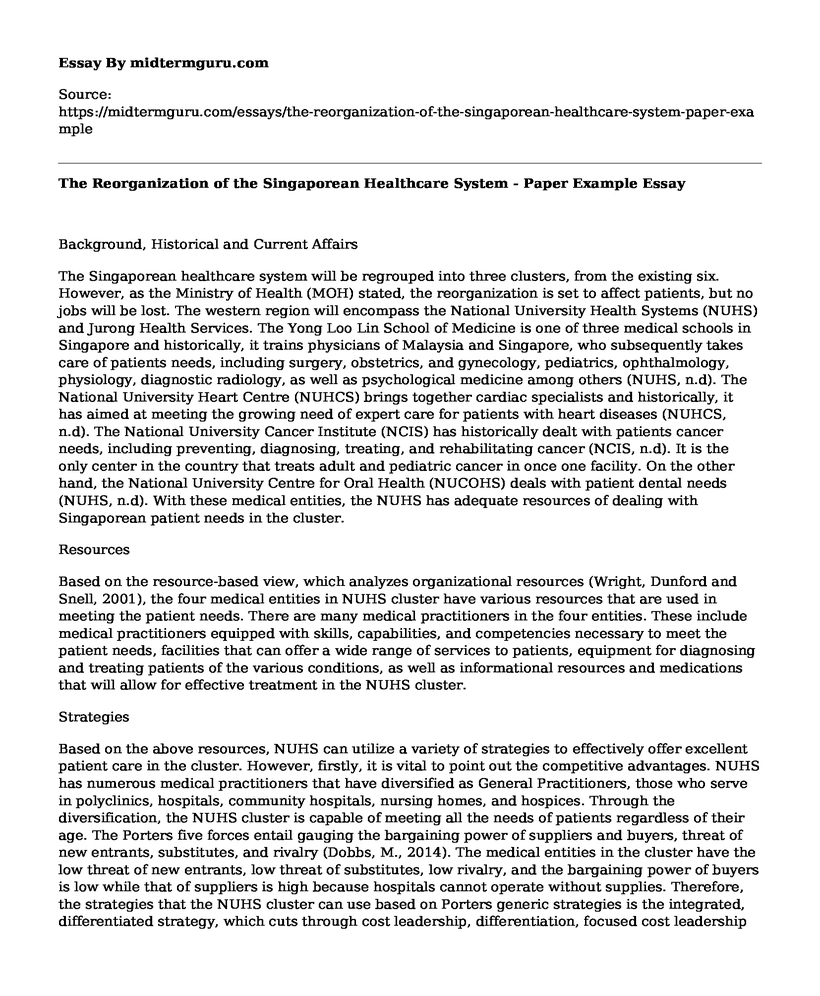Background, Historical and Current Affairs
The Singaporean healthcare system will be regrouped into three clusters, from the existing six. However, as the Ministry of Health (MOH) stated, the reorganization is set to affect patients, but no jobs will be lost. The western region will encompass the National University Health Systems (NUHS) and Jurong Health Services. The Yong Loo Lin School of Medicine is one of three medical schools in Singapore and historically, it trains physicians of Malaysia and Singapore, who subsequently takes care of patients needs, including surgery, obstetrics, and gynecology, pediatrics, ophthalmology, physiology, diagnostic radiology, as well as psychological medicine among others (NUHS, n.d). The National University Heart Centre (NUHCS) brings together cardiac specialists and historically, it has aimed at meeting the growing need of expert care for patients with heart diseases (NUHCS, n.d). The National University Cancer Institute (NCIS) has historically dealt with patients cancer needs, including preventing, diagnosing, treating, and rehabilitating cancer (NCIS, n.d). It is the only center in the country that treats adult and pediatric cancer in once one facility. On the other hand, the National University Centre for Oral Health (NUCOHS) deals with patient dental needs (NUHS, n.d). With these medical entities, the NUHS has adequate resources of dealing with Singaporean patient needs in the cluster.
Resources
Based on the resource-based view, which analyzes organizational resources (Wright, Dunford and Snell, 2001), the four medical entities in NUHS cluster have various resources that are used in meeting the patient needs. There are many medical practitioners in the four entities. These include medical practitioners equipped with skills, capabilities, and competencies necessary to meet the patient needs, facilities that can offer a wide range of services to patients, equipment for diagnosing and treating patients of the various conditions, as well as informational resources and medications that will allow for effective treatment in the NUHS cluster.
Strategies
Based on the above resources, NUHS can utilize a variety of strategies to effectively offer excellent patient care in the cluster. However, firstly, it is vital to point out the competitive advantages. NUHS has numerous medical practitioners that have diversified as General Practitioners, those who serve in polyclinics, hospitals, community hospitals, nursing homes, and hospices. Through the diversification, the NUHS cluster is capable of meeting all the needs of patients regardless of their age. The Porters five forces entail gauging the bargaining power of suppliers and buyers, threat of new entrants, substitutes, and rivalry (Dobbs, M., 2014). The medical entities in the cluster have the low threat of new entrants, low threat of substitutes, low rivalry, and the bargaining power of buyers is low while that of suppliers is high because hospitals cannot operate without supplies. Therefore, the strategies that the NUHS cluster can use based on Porters generic strategies is the integrated, differentiated strategy, which cuts through cost leadership, differentiation, focused cost leadership and focused differentiation (Brenes, Montoya and Ciravegna, 2014). The strategy encompasses a trade-off between market scope and competitive advantage (Tanwar, 2013). Based on the approach, NUHS cluster will be able to meet the needs of all the patients because they can divide them up and put them in the four of the Porter generic strategies.
How MOH Objectives are met
The healthcare 2020 Masterplan for Singapore is based on three measures: quality, affordability, and accessibility (MOH, 2012). Based on the strategic move adopted in the NUHS cluster, the quality measure met by ensuring that the practitioners have the skills and competence needed to meet the needs of the patients. By using a low cost and focused cost leadership, the MOH objective of affordability will be fulfilled because as Banker, Mashruwala, and Tripathy (2014) purport, low cost allows for the patients to pay for the healthcare services. Also, accessibility will be met as the patients will be able to pay for the services in all the medical facilities in the cluster.
References
Banker, R., Mashruwala, R. and Tripathy, A., (2014). Does a differentiation strategy lead to more sustainable financial performance than a cost leadership strategy?. Management Decision, 52(5), pp.872-896.
Brenes, E.R., Montoya, D. and Ciravegna, L., (2014). Differentiation strategies in emerging markets: The case of Latin American agribusinesses. Journal of Business Research, 67(5), pp.847-855.
Dobbs, M., 2014. Guidelines for applying Porter's five forces framework: a set of industry analysis templates. Competitiveness Review, 24(1), pp.32-45.
National University Cancer Institute, Singapore (NCIS) (n.d). What We Do. [Online]. Available from http://www.ncis.com.sg/about-us/what-we-do.html (Accessed 25 March 2017).
Ministry of Health (MOH) (2012). Healthcare 2020: Improving Accessibility, Quality & Affordability [Online]. Available from https://www.moh.gov.sg/content/dam/moh_web/healthscope/archive/2012/MOH%20Healthscope_July-August%202012%20Issue.pdf (Accessed 25 March 2017).
NUHS (n.d). Yong Loo Lin School of Medicine. [Online]. Available from http://www.nuhs.edu.sg/education/yong-loo-lin-school-of-medicine.html (Accessed 25 March 2017).
National University Heart Centre, Singapore (NUHCS) (n.d). What We Do. [Online]. Available from http://www.nuhcs.com.sg/what-we-do.html (Accessed 25 March 2017).
NUHS (n.d). National University Centre for Oral Health, Singapore (NUCOHS). [Online]. Available from http://www.nuhs.edu.sg/patient-care/national-university-centre-for-oral-health-singapore-2019.html (Accessed 25 March 2017).
Tanwar, R., (2013). Porters generic competitive strategies. Journal of Business and Management, 15(1), pp.11-17.
Wright, P.M., Dunford, B.B. and Snell, S.A., (2001). Human resources and the resource based view of the firm. Journal of management, 27(6), pp.701-721.
Cite this page
The Reorganization of the Singaporean Healthcare System - Paper Example. (2021, Jun 14). Retrieved from https://midtermguru.com/essays/the-reorganization-of-the-singaporean-healthcare-system-paper-example
If you are the original author of this essay and no longer wish to have it published on the midtermguru.com website, please click below to request its removal:
- Essay on Developing the Leader Within You by Maxwell
- Articles Analysis on Changes in Healthcare - Paper Example
- Paper Example on Critical Decision Making for Providers
- Essay on Defining a Great Leader
- Paper Example on Sourcing Products in a Global Marketplace
- Reasons Hippocrates Gives to Explain Why Disease Should Not Be Called Sacred - Paper Example
- Heroin Use in US: The Increase, Benefits and Disadvantages - Essay Sample







